In June 2018, I walked the north-south streets of the Lower East Side from Orchard east to Pitt between Houston and East Broadway/Grand/Delancey and noticing what I saw. I obtained over 300 photos, many of which will be used in this multipart series, which may necessitate a rare midweek feature page. There is more work to be done. I should walk Rivington, Stanton and Broome again, and I have yet to walk Hester, Allen, Eldridge and Forsyth; perhaps that will come during the summer.
GOOGLE MAP: STREETS OF THE LOWER EAST SIDE
![]()
Like Norfolk Street, Suffolk Street presently runs from Grand Street north to East Houston. From here on east, most north-south Lower East Side streets except Clinton are truncated versions of their former selves, with large patches taken over by public housing projects, specifically the Seward Park Houses (since 1959).

Until the Essex Crossing project is done, construction blocked me from walking on the section of Suffolk south of Delancey–which features the only Belgian blocked street in the neighborhood, which I have to believe will be paved over when the towers are finished. Here’s some pedal to the metal, Williamsburg Bridge-bound traffic on Delancey.

The pedestrian/bike entrance ramp to the Williamsburg Bridge. It’s an exceedingly long one so I generally avoid walking the bridge, which opened in 1903 connecting the Lower East Side with Williamsburg. In ensuing decades it would be connected to the Brooklyn-Queens Expressway.
The ramp played an important role in 1948’s Naked City, in which the killer is chased up the ramp and is shot dead on the Manhattan-side tower.
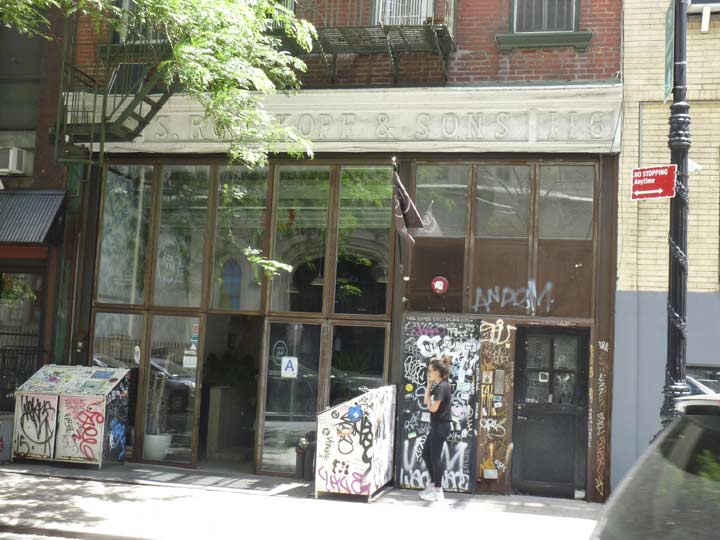
#116 Suffolk between Delancey and Rivington is Spreadhouse, which as nothing to do with Country Crock but bills itself as a full-service video production business that doubles as a café. #116 was also home to the art-house Lighthouse Cinema and originally, as it says above the door, S. Rothkopf & Sons, a manufacturer of children’s pajamas. In 1896, Henry Rothkopf, a son of the founder, shot himself in his office.
The massive medieval-styled castle at the SE corner of Rivington and Suffolk is the former Public School 60, originally built in 1898 by prolific schools architect C.B. J. Snyder, is now the Clemente Soto Velez Cultural and Educational Center: “The Clemente’s mission is focused on the cultivation, presentation, and preservation of Puerto Rican and Latino culture, it is equally determined to operate in a multi-cultural and inclusive manner, housing and promoting artists and performance events that fully reflect the cultural diversity of the Lower East Side and the city as a whole.”

150 Rivington Street at Suffolk is a new glassy condominium that replaced the old Streit Matzoh Factory.
In 1897 Aaron and Nettie Streit came to America from Austria. They went into business making Matzohs by hand, following kosher methods of preparation, at nearby 65 Pitt Street. Aaron Streit was joined by his two sons and expanded operations to the building in 1925 and purchased three adjacent buildings. Streit’s remained the only family owned and operated matzoh bakery in the USA and it was operated by the grandchildren of Aaron and Nettie until it closed in 2015.
Over the years since I started FNY the LES has lost some of its infrastructural majesty, in the form of ancient painted ads and signs. There are a couple still left — one of them is the magnificent neon Louis Zuflacht sign at Stanton and Suffolk Streets; the “154” is the Stanton Street address. This sign has persisted despite Zuflacht going out of business several decades ago; tenant after tenant has moved in, and amazingly, kept the sign. In 2014 there was worry it had finally succumbed, as it was covered with a sign for an antiques store, but that was a prop for a TV show called Forever, about an unwilling immortal. (I’d be for immortality as long as someone picks up my meals, room and board and health care.)
I haven’t gone into who Louis Zuflacht was yet. Even the Indispensable Walter Grutchfield does not mention him. However, the blogger called Brooks of Sheffield did, in his terrific Lost City, which he stopped writing in 2014 ( your webmaster, me, has no life and so FNY will continue ad infinitum). Zufrecht was a long-lived haberdasher (1883-1986) who operated the store beginning about 1940; the sign was commissioned in 1942. Zufrecht’s sons, Jack and Joe, ran the business for a time. Unfortunately, neither Brooks nor I know the precise date the store shut down.
The storefront continues to be for rent (the sign obscuring the Stanton Street side) and who knows if any new renter will be indulgent enough to retain the old neon sign.
Street art of different eras at Suffolk and Stanton. The tangoers are on Argentinian restaurant Balvanera.
A pair of oldstyle walkup apartment buildings at #176 and #169.

The spire of Most Holy Redeemer Church (1852) on East 3rd Street between Avenues A and B watches over the Suffolk-East Houston Streets.
![]()
Clinton Street, which retains its original length from South Street north to East Houston, is not named for DeWitt Clinton (NYS governor, US representative and Senator and the mastermind behind the Erie Canal) as many other NYC streets named “Clinton” are. Rather it is named for his uncle General George Clinton (1739-1812) who fought in the US Revolution and was a longtime NYS Governor and later Vice President under both Jefferson and Madison.

North of East Houston Street, Clinton Street becomes Avenue B.
Much of Clinton Street is illuminated by sidewalk lamps and by this time, all uniformity has vanished and we have a mismatch of varieties — there are the short brown posts carrying New Gumballs, mostly found under elevated trains, and Type A lamps and octagonal post-tops mostly found in parks. Very entertaining for lamp buffs.

Congregation Chasam Sopher, 8-10 Clinton, was constructed in 1853 and is the second oldest building used as a synagogue in the Lower East Side; the current Angel Orensanz Center on Norfolk (1849) is the only one that outranks it. The congregation Rodeph Sholom was founded in 1842 on Attorney Street by German Jewish immigrants and constructed this building 11 years later, and moved uptown in 1891. The present congregation moved in the same year.

Is this the Grand Concourse? No, an atypically large 1930s-style apartment building at #24 Clinton between East Houston and Stanton.

More typical 1880-1910 brickface, at #40-42 Clinton between Rivington and Stanton

USA Chinese Women Federation and Scumbags and Superstars, “clothing inspired by vintage horror movies, monsters, & comics.” I thought it was a biker bar when I saw the sign. #100 Clinton. The shop closed in April 2018, but still has an online presence.
![]()
Deciding to skip Clinton Street’s southern stretch (it turns southeast past East Broadway, the only north-south street between Grand and East Houston that does so) I headed back north along Attorney Street, which has been truncated since 1959 by the Seward Park Houses but also by PS 140 which fronts a block east, on Ridge.
When Attorney Street was mapped in the 1790s, a number of prominent attorneys including US Supreme Court Justice Henry Livingston owned property in the vicinity. Thus, it’s one of the few NYC streets named for a profession.

PS 142, the Amelia Castro school, built 1975, is donut-shaped with circular outer walls and an interior courtyard.
Architecture from 1910 and 2015, near the Attorney-Stanton intersection.

The Stanton Street Shul, 180 Stanton between Clinton and Attorney, was built in 1913 and is one of the few remaining tenement-style synagogues. Its longtime leader Rabbi Joseph Singer, who served from 1964-2002, was a tireless advocate for the poor and elderly of the Lower East Side. Though he was never paid for his years of service, he was forced out after he tried to arrange for the building’s sale, with the synagogue’s board members, to a theater workshop. After that incident, however, the synagogue revived and is now the center of a healthy religious and cultural scene, hosting art exhibitions and jazz and klezmer music.
I don’t know how I overlooked Parkside Lounge and its neon signs at 317 East Houston, corner of Attorney, but Google Street View remedied the oversight.
![]()
Ridge Street runs between East Houston and Broome. It is named for a former hill in the Lower East Side that was mostly leveled when the streets were laid out in the early 1800s.
I walked Ridge Street a few years ago, and one of its most intriguing tidbits, at #124 south of Stanton, is no longer there although the building is.
I noticed an unusual door treatment and sign at #124 Ridge: a piano keyboard above the air conditioner, and a battered, graffitied sign saying “Treuhaft’s Concert Basement” above concrete steps, leading down to a gated basement. There had to be a story behind this, I thought, and I was right.
Upon visiting Cuba in 1993, Benjamin Treuhaft noticed that the remaining pianos in that country were being ravaged by humidity, decrepitude and termites, and the piano tuner decided to attempt to remedy the situation:
“Most of the pianos here were Soviet-made: many of them from Moscow and Estonia, so they weren’t that great to begin with,” Treuhaft said during a visit this week. “Then, they met the Cuban termites. And then, they met the Cuban pianists, who are great, but strong, and can really destroy an instrument.”
Treuhaft keeps returning to survey donated instruments and tune and restore others, striking an insistent chord against the U.S. trade embargo. After nearly 20 trips to the island -some without U.S. approval – the jocular former hippie who sports a bandanna on his head and likes to tune pianos barefoot is now a personality in some Cuban music circles.
After Treuhaft repaired Jorge Lopez Marin’s dilapidated Russian piano, the Havana composer wrote a traditional Cuban song for him called “El Medico de Piano”- or “The Piano Doctor.” The tune is now widely performed by a popular women’s musical group.
“What he has done is very important for the music community in Cuba,” said Julia Diaz, a Cuban piano tuner who has known Treuhaft for 12 years. “He is very much beloved here.”
Cubans admire Treuhaft’s dedication to his craft, and delight in his playful personality. Concord Monitor [link taken down]
He now has US State Department permission to check on donated pianos. Although based mostly in Berkeley, CA, Treuhaft has worked at the Steinway and sons Concert Basement in NYC, and though I can’t find anything specific about a “Treuhaft Concert Basement” this place must have had some connection with him.

#202 at the corner of Rivington and Ridge wasthe girlhood home of Genya Ravan, who has been rocking for over 40 years. Here she is with one of her first hits with Goldie and the Gingerbreads in 1964:

Across the street at the SE corner of Rivington and Ridge is a massive former public school, PS 4, #130 Rivington, now condominiums.
![]()
Pitt Street runs north from Grand Street, where Samuel Dickstein Plaza connects it with Montgomery Street, north to East Houston. It was not named for William Pitt, the Earl of Chatham (1708-1778) a British Prime Minister who supported the colonies in their fight for independence. Chatham Square, where East Broadway and the Bowery meet, is also named for him as was East Broadway when it was called Chatham Street.
While the east side of Pitt Street faces the Samuel Gompers Houses and Hamilton Fish Park, some of the Lower East Side’s more attractive tenement buildings can be found on the west side, as here at Rivington.

Interesting modern tilework at the entrance of #91 Pitt.

Our Lady of Sorrows Roman Catholic Church, 105 Pitt Street, part of a very old complex administered by the Capuchins. This church building was dedicated in 1868; the congregation was founded 11 years earlier to serve immigrant German Catholics. Today it serves primarily Latino congregants.
The Order arose in 1520 when Matteo da Bascio, an Observant Franciscan friar native to the Italian region of the Marches, said he had been inspired by God with the idea that the manner of life led by the friars of his day was not the one which their founder, St. Francis of Assisi, had envisaged. He sought to return to the primitive way of life of solitude and penance as practiced by the founder of their Order. wikipedia
The Order is named for the cappuccio, or hooded robe worn by members.
In 1890, the parish gained a spectacular Gothic Capuchin monastery, now the rectory (priests’ residence). On the building is mounted a bronze plaque with the many area residents who perished fighting in World War II.

The magnificent Beaux Arts Hamilton Fish Park Play Center on the east side of Pitt north of Stanton was designed by Carrere and Hastings (who also designed the New York Public Library at 5th Avenue and west 42nd) and constructed in 1898, modified in 1903, with a swimming pool added in 1936. The pool was used by the US Olympic swim team in preparation for competition at the 1952 Helsinki games.
Hamilton Fish (1808-93),served NY State as a member of the U.S. House of Representatives (1843-45), as the governor of New York State (1849-51), and as a U.S. senator (1851-57). He is most noted for his service as secretary of state (1869-77) under President Ulysses S. Grant. The Fish family has been prominent in NY State politics and commerce for parts of three centuries.
My north and south Lower East Side walk ended here at Pitt and East Houston, but much more about this fascinating part of town can be found in Joyce Mendelsohn’s Lower East side Remembered and Revisited (Columbia University Press, 2009)
Check out the ForgottenBook, take a look at the gift shop, and as always, “comment…as you see fit.”
7/15/18



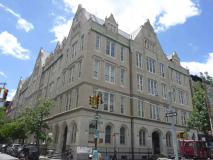


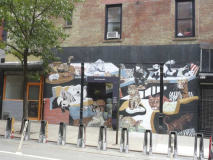






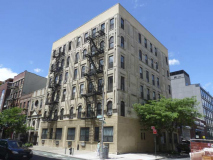







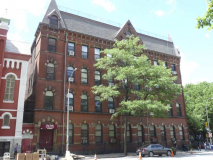

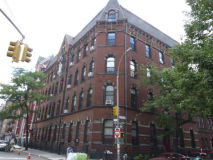
11 comments
who did “Can’t You Hear My Heart Beat?” first?
Herman’s Hermits or Goldie and the Gingerbreads?
Streit’s moved the matzoh factory to Rockland County a few years ago. The LES factory was too small, and lacked an off-street loading area.
“When Attorney Street was mapped in the 1790s, a number of prominent attorneys including US Supreme Court Justice Henry Livingston owned property in the vicinity. Thus, it’s one of the few NYC streets named for a profession”
One more- Paine Street in the Bronx is named for dentists… (somewhat expected joke…..)
Naked City is one of my favorite movies. But looking at that climactic final scene on the Williamsburg Bridge you would almost never know today it’s the same structure. The entire Manhattan side was reconstructed in the last twenty years, and the only remaining part of the original fancy masonry entrance at Delancey Street is the small structure in the photo. In the movie scene there were stairs that led up to the pedestrian walkway, which were replaced with the ramp. The killer bumped into a blind man and his guide dog on those stairs, panicked, and shot the dog. The sound of the gunshots alerted the police, who were on Delancey Street, and chased the killer onto the bridge tower. It’s one of the best NY movie scenes ever filmed.
I know that movie.It has one of the biggest clichés in movies-the screaming man falling past the girders and beams.
People don’t scream when they fall from heights.
As kids we would imitate screaming falling men for kicks.
Thank you for your hard work. My dad grew up at 143 Division st. I enjoyed looking through your pictures and descriptions.
Ridge Street didn’t always terminate at Brooke Street. Before urban renewal, Ridge ran one block farther to Grand Street, where St. Mary’s Church still stands, one of the oldest Catholic congregations in NYC.
I grew up at 34 Ridge (which no longer exists) from 1958 to 1967, next door to Dominic’s tailor shop and the East Side Iron Works. From what I understand, one of the bloodiest engagements of the 1863 Draft Riots occurred right outside what would have been our doorstep. The families of the crew of the U.S.S. Monitor lived one block further east on Pitt Street.
The official address of the art deco style building is 20 Clinton St, not 24 Clinton. Built in 1939, it occupies 4 tax lots, 18-24 Clinton. It converted to condominium in 1999.
Does anyone remember ida oscards restaurant on Rivington
Street? It was down a few steps on the left, and on the right
There were steps leading to apartments. If you do, please
E mail me at judi79@aol.com. It would be helpful if you
remember the address or hsve any pictures. Thank you.
Or have any pictures
Trying to find photos of 238 Rivington street at the almost corner of Willet street which was north of the Williamsburg Bridge— this building and others along that particular block were taken down to make room for the Projects to be built which still stand today— I’ve tried in vain to find a photo— there also used to be a grocery store located right on the corner and a hardware type store directly across the street— and a drug store located on the north west corner of Rivington and Willet streets— any photos would be greatly appreciated— please send to jamame46@yahoo.com— thank you so much
https://1940s.nyc/map/photo/nynyma_rec0040_1_00338_0015#18.53/40.7180806/-73.9820034